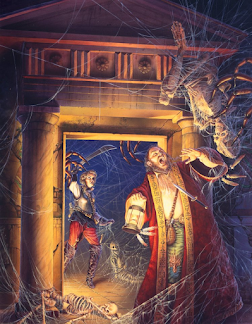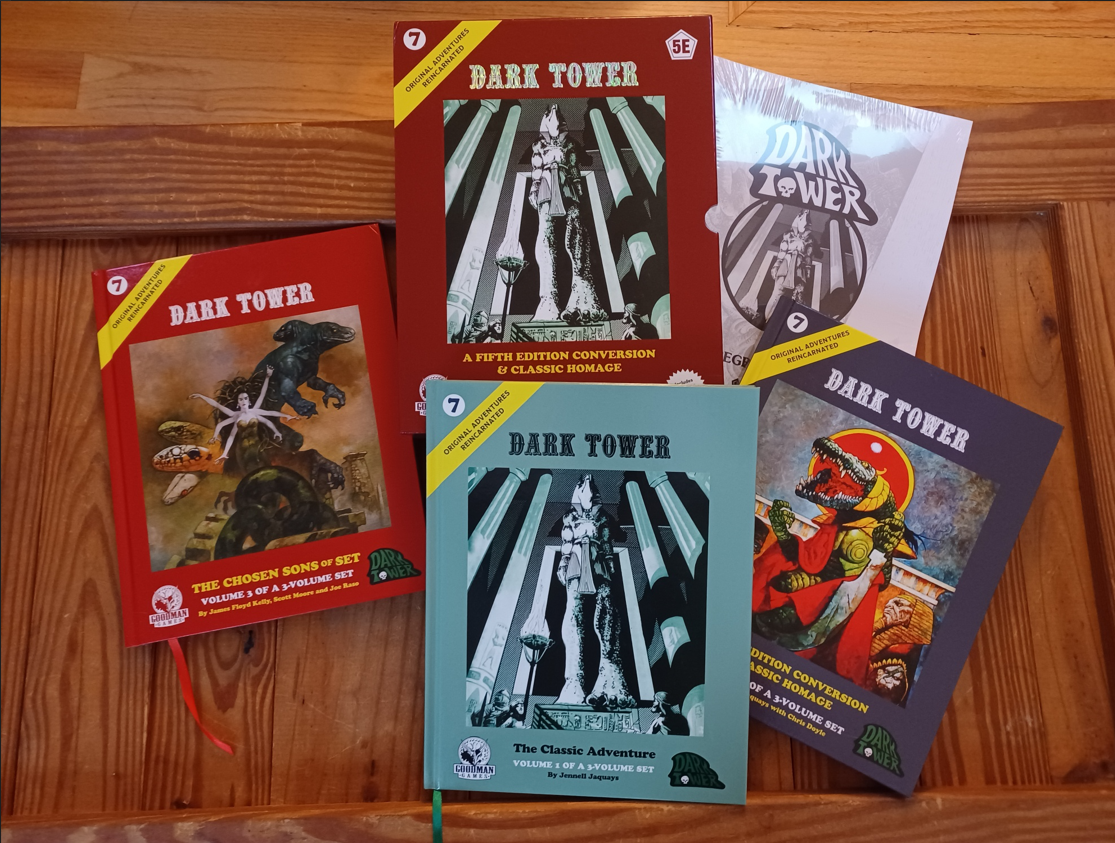Dark Tower by Jennell Jaquays and others, Goodman Games, Goodman Games, 2024, consisting of a 96-page hardback, a 316-page hardback, a 164 page hardback, additional handouts, slipcased, Kickstarter.
Jennell Jaquays (1956-2024) was an artist and designer of tabletop and computer games. She was brilliant at all these things. I had an opportunity to work with her when she joined TSR as an artist, producing the covers for the Mystara revision, as well as a beautiful piece of a wounded Nautiloid for Spelljammer, and she further immortalized me on the cover of a D&D product - Temple, Tower, and Tomb. She passed on in January of this year. Her work spanned numerous companies, some of which she founded, and she was there when the dawn first broke over the horizon of RPGs with Dark Tower.
Dark Tower was originally produced by Judges Guild, and was a 70-page adventure dealing with a secretive cult of Set that had taken over a small community. The adventure consisted of that small town (called Mitra's Fist), and an extensive dungeon beneath it, filled with traps and creatures. The tower of the title is underground. But what established itself over other adventure models of its era was its non-linear design. There were multiple entrances, multiple passages between levels, and across levels between two sunken towers. This type of design has since been giving many names, but I'm comfortable with Jaqaysing as its nom du design.
Jaquays produces interesting adventures that veer away from standard approaches. For a linear dungeon design (good for tournaments), you move directly from room to room, and from encounter to encounter. One entrance (usually) and one exit from each encounter. There may be nests and complexes, but the assumption is that you cleaned out one room or section before moving forward. Everyone has the same experience. In as Jaquays-styled dungeon, there are multiple ways up and down and across, and there is no guarantee that the adventurers will hit everything. The original Ravenloft would pull off the same trick years later, but Dark Tower was first, and set a high bar.
Jaquaysing does have some challenges. A linear dungeon works for linear storytelling. You can feed the player characters information over time. Under a non-linear dungeon, encounters and clues may be missed entirely, so creating a strong story sense can be a challenge to the DM. In Dark Tower, the players slowly piece together what is going on, and may not engage with the entire story, depending on their choices.
In addition, in this form of dungeon, adventurers can quickly find themselves in over their heads, particularly if the dungeon levels are set for different character levels John "Sacnoth" Rateliff ran us through it in preparation of his essay (which is included in the deluxe edition), and I ended our experience suddenly when I accidentally used the door from a Robe of Useful Items to open a passage into the high-level final boss fight room. OK, maybe it wasn't totally the dungeon design's fault, but it did have the potential to go casters-up and then did.
 |
| The cover of Temple, Tower & Tomb. I'm the one screaming. |
Volume 2, by Chris Doyle, is a massive translation of the original adventure in 5th Edition D&D (though the game is not directly referred to as such). The text has expanded, and the appendices are almost twice the size of the original, But it brings the classic adventure forward for more modern audiences. Plus there is more on the overworld around Dark Tower.
Book 3 by a number of folk, is a continuation of the story at the post-12th level, continuing the themes of Mitra versus Set through a number of smaller dungeons. There is definitely a feeling "But wait, there's more" going on here, but it is all begun with Dark Tower, which remains the centerpiece of the project.
This is a Goodman Games production, which means it has old-school black and white interiors and there are numerous player handouts and character sheets (also part of the Kickstarter). The art is solid and evokes the rough edges of the earlier editions of D&D and maps look good and complete (the originals were pretty spiffy as well). The combined projects both show where we have been in design, and where we have grown, and are playable in either configuration.
In short, they did well by Jennell, and the revised, updated, and expanded Dark Tower is as challenging and engaging as the original was. It is an excellent testament to her contributions in RPGs.
More later,




